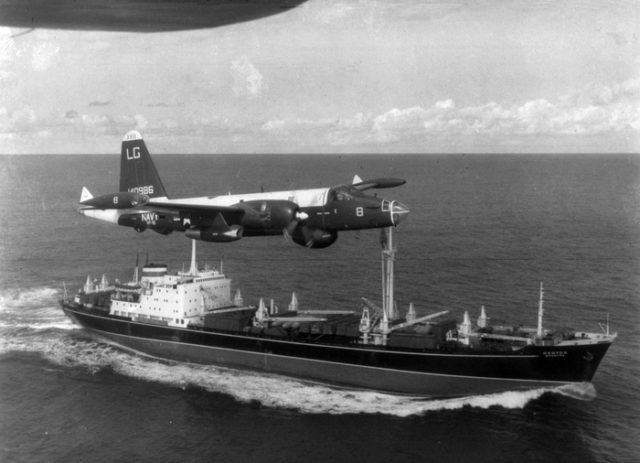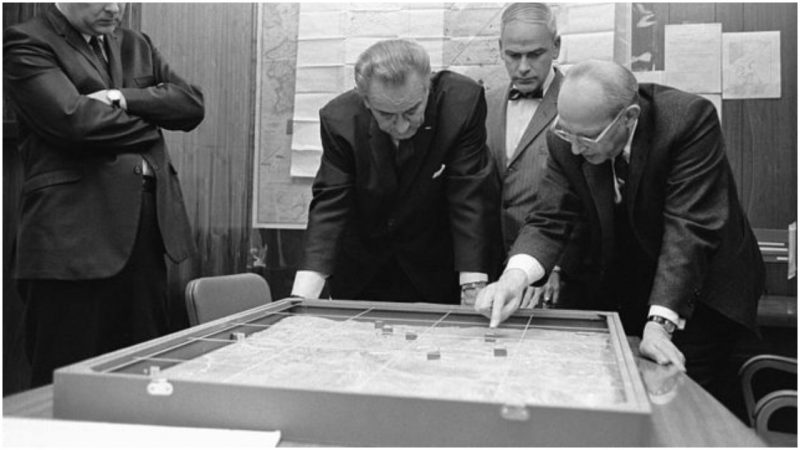The president of the United States is the commander-in-chief of the armed forces, and the only person who may issue a direct authorization of a nuclear attack. There are several fixed command centers equipped with the technology that may be used to authorize such an attack. The most famous of these command centers is the John F. Kennedy Conference Room, informally known as the “Situation Room,” which is located in the basement of the West Wing of the White House.
Starting with the beginning of the Cold War, the U.S. military was poised to carry out a nuclear attack at any point in time. However, in the early 1950s, the military advisors of President Dwight D. Eisenhower realized that, since the president travels frequently, he might not always be able to reach a fixed command center to authorize a retaliatory nuclear attack in the event of a Soviet move. Therefore, the military constructed what became known as the “Nuclear Football” or the “President’s Emergency Satchel”: a portable communications device that is connected to the U.S. strategic defense system and may be used by the president to authorize a nuclear strike at any time.
Although the Football was introduced when Eisenhower was in office, it entered presidential service in late 1962, in the aftermath of the Cuban Missile Crisis. President John F. Kennedy was extremely worried that the Soviet armed forces stationed in Cuba might launch nuclear missiles toward the United States without authorization from Moscow, so he decided to keep the Football by his side at all times; this tradition soon turned into a rule.

The Nuclear Football is a thick briefcase coated in fashionable black leather and manufactured by the company Zero Halliburton. Aside from a communications device, the briefcase contains the so-called “Black Book,” a list of all possible retaliatory options that may be chosen in the event of a nuclear attack on the U.S. It also contains a book listing classified military site locations and a manual depicting the procedures for the Emergency Alert System. The most important item in the briefcase is the authorization card, a credit card-like plastic card containing nuclear attack authorization codes.
The Nuclear Football is by the president’s side whenever he is away from fixed command centers: it is carried by one of his closest aides and can even be spotted during some public events. If the president were to order a nuclear attack, he would use the Football to contact the Secretary of Defense or one of the Secretary’s underlings. The Secretary of Defense or his personnel, the only people other than the president who possess the authentication codes, would then verify the codes sent by the president, review the president’s attack plan, and proceed with the attack order. Since the president is at the top of the chain of command and has absolute military power, the Secretary of Defense or his personnel may review the president’s attack plan but cannot legally disobey his order: They are obligated to initiate the attack.

The Football generated controversy in the early 1970s when a U.S. Air Force major was discharged for questioning the ethics of the device and its usage. In 1973, Major Harold Hering, a Vietnam War veteran who had been awarded the Distinguished Flying Cross for his combat achievements, was training to become a Minuteman missile crewman who would serve under the Secretary of Defense and would be responsible for reviewing the president’s hypothetical nuclear attack order and proceeding with the order.
At one point during the training, Hering asked, “How can I know that an order I receive to launch my missiles came from a sane president?” The question revealed a flaw in the process of authorizing a nuclear attack via the Nuclear Football: the official receiving the order would have to proceed with the attack without knowing whether the order was issued by a president who was drunk, neurotic, or forced to issue the order by someone else.

Hering’s question sparked much debate on the ethics of the Nuclear Football and the nuclear arms race itself, and Harper’s magazine even published a 15,000-word article in which journalist Ron Rosenbaum argued that Major Hering exposed a fatal flaw in the very foundation of the Nuclear Football system.
However, the debates never brought about any change in the system; the Nuclear Football is still operational and is present by the president’s side at all times. Furthermore, Major Hering was discharged from the U.S. Air Force because the Board of Inquiry ruled that he failed to demonstrate acceptable qualities of leadership and instead expressed disobedience toward the chain of command.
